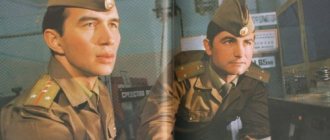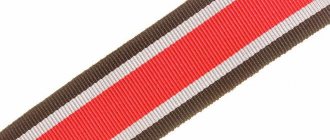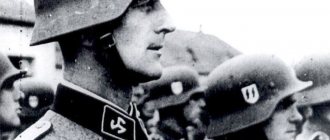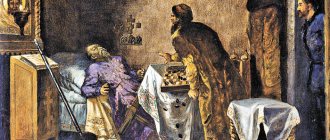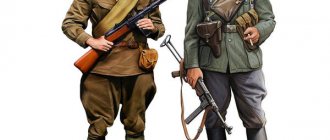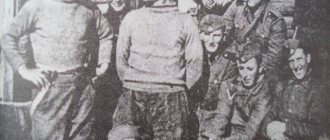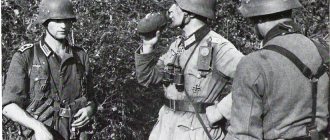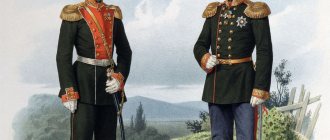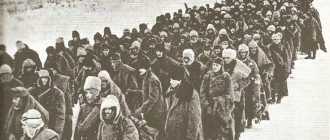Why SS tattoos?
The Waffen SS troops differed from ordinary Wehrmacht soldiers in their high level of political training and commitment to the ideas of Nazism. Germany valued every such soldier very much, so she tried to do everything to save his life.
That is why, on the back of the arm, all SS soldiers were tattooed with their blood type. This information could speed up the saving of a soldier's life if an urgent blood transfusion was suddenly required in the hospital.
Such tattoos were made using a special mark, which left a noticeable mark on the skin.
It is noteworthy that SS officers were not given such tattoos, so as not to discredit them in case they were captured.
SS veteran and his tattoo
If you think that the place for a tattoo is rather strange, then German experts will not agree with you. Even before the start of World War II, they collected statistics and found out that this particular area of the body is least likely to be damaged.
The history of the SS (Schutz Staffeln - security detachments) begins in the early 1920s, when a group of bodyguards for Adolf Hitler was formed as part of the SA (Sturmabteilungen - assault battalions). By 1929 the SS numbered less than 300 men, but by 1933 it had grown to 30,000 men. The security detachments, under the command of Heinrich Himmler, consisted of three gendarmerie battalions. It was through the forces of the SS that Hitler managed to become the sole leader of the NSDAP during the “night of the long knives” on June 30, 1934... By the beginning of the Second World War in 1939, the SS had only a few small armed units - the SS-Verfuegungstruppe. The military viewed the SS with suspicion, seeing them as a kind of gendarmes, incapable of conducting regular combat .
The first experiences of war in France and then in the Soviet Union changed this attitude. In several stages, the SS-Verfuegungstruppe became organized into a structure that became known as the Waffen-SS. By the end of 1943, the SS troops already numbered several battle-hardened mechanized and tank divisions. Unlike the first years, when obsolete or captured models entered service with the SS troops, now the Waffеn-SS had the highest priority, receiving the most modern German military equipment and weapons.
| SS Standartenführer uniform, 1933. Note the cap with piping - a feature of the uniform of senior officers. The thyr rune worn by graduates of the SA-Reichsfuehrerschule is visible on the shoulder. |
| "SS Uniforms and Artifacts in Color Photographs" (Soldier at the Front No. 25) |
The SS troops became the striking force of the German army... By the spring of 1945, the number of divisions had increased to 38. Although many of these 38 divisions existed only on paper or were still in various stages of formation, the combat effectiveness of the SS troops was steadily growing. SS corps and even two SS armies were formed, although these formations, in addition to the SS, also included army units.
| Sleeve emblem in the form of an SS eagle for enlisted personnel, machine embroidery. Unlike the Wehrmacht, where the eagle was worn on the right side of the chest, the SS wore it on the left sleeve. |
| "SS Uniforms and Artifacts in Color Photographs" (Soldier at the Front No. 26) |
The SS divisions were tactically subordinate to the OKW, but the Waffen-SS had its own command structure, which was personally headed by Reichsführer-SS Heinrich Himmler. In the summer of 1940, simultaneously with the transformation of the SS-Verfuеgungstruppe into the Waffen-SS, the SS-Fuehrunghauptamt was formed, which took over operational control of the SS troops.
| Emblems for SS headdresses between 1923 and 1945. The imperial cockade gave way in 1929 to the NSDAP eagle, and in 1934 the Prussian death's head was replaced by an SS death's head, which had a lower jaw. In 1936 the characteristic SS eagle appeared. The emblems were first made of tombac bronze, then of aluminum and finally of zinc. |
| "SS Uniforms and Artifacts in Color Photographs" (Soldier at the Front No. 25) |
The rank structure of the Waffen-SS and their names were completely borrowed from the General SS (Allgemeine-SS). Instead of one shoulder strap on the right shoulder, adopted by the Allgemeine-SS, Waffen-SS soldiers wore shoulder straps on both shoulders - in the army style. At the same time, the practice of wearing insignia only in the left buttonhole has been preserved. With minimal changes, this system existed until May 1945.
In general, the ranks in the army and SS troops were the same. Thus, the army rank of captain (Hauptmann), which usually corresponded to the company commander, had an analogue in the SS troops - SS-Hauptsturmfuehrer. Also the rank of colonel (the position of “regiment commander” was available both in the army (Oberst) and in the SS (SS-Standartenfuehrer). Ranks in the SS troops historically arose from the names of positions, therefore they consisted of two parts - the name of the detachment commanded by this commander , and the words Fuehrer, that is, “leader,” “ commander .” (more about SS ranks)
| SS buttonholes and shoulder straps |
| General: 1st Reichsführer SS; 2- SS Oberstgruppenführer; 3rd SS Obergruppenführer (until 1942); 4th SS Obergruppenführer (after 1942); 5th SS Gruppenführer (until 1942); 6th SS Gruppenführer (after 1942); 7th SS Brigadeführer (until 1942); 8th SS Brigadeführer (after 1942). |
| Officers (the color of the shoulder strap corresponded to the branch of the army): 9th SS Oberführer (until 1942); 10th SS Oberführer (after 1942); 11th SS Standartenführer (until 1942); 12th SS Standartenführer (after 1942); 13th SS Obersturmbannführer (until 1942); 14th SS Obersturmbannführer (after 1942); 15th SS Sturmbannführer (until 1942) - veterinary service here; 16th SS Sturmbannführer (after 1942); 17th SS Hauptsturmführer; 18th SS Obersturmführer; 19th SS Untersturmführer. |
| Non-commissioned officers and enlisted personnel: 20-SS Sturmscharführer; 21- SS Hauptscharführer; 22nd SS Oberscharführer; 23rd SS Scharführer; 24-SS Unterscharführer; 25th SS Rottenführer; 26- SS Sturmmann; 27 - SS Oberschütze (a silver-gray bump on a black circle was worn on the sleeve); 28- SS Schutze. |
| Source : Bender, Taylor “Uniform, organization and history of the SS troops” part 1 |
In the “non-Nordic” SS units that were formed towards the end of the war, the prefix SS- was changed to the prefix Waffen-. For example, a Hungarian who was awarded the position of captain was called Waffеn-Hauptsturmfuehrer.
If not a regular division was formed, but a foreign legion, then the prefix was changed to Legion and it sounded like Legion-Hauptsturmfuehrer.
| White SS Untersturmführer's casual uniform. |
| "SS Uniforms and Artifacts in Color Photographs" (Soldier at the Front No. 25) |
These modifications of ranks were explained by the fact. that Heinrich Himmler was seriously passionate about the theory of racial superiority, and therefore did not want non-Aryans to wear the sacred SS runes. For foreigners, buttonholes of a special type were also required, without runes. But the Germans who served in these divisions had the right to wear runes on their left breast pocket, thereby emphasizing their status as full-fledged members of the SS.
| Commander's pennant and leather pennant case. All junior SS officers were required to carry such pennants If the officer got out of his car, the pennant was supposed to be removed. |
| Information: “SS Uniforms and Artifacts in Color Photographs-III” (Soldier at the Front No. 27) |
Non-commissioned officers, starting with the SS Rottenführer, wore on their sleeves a chevron made of aluminum or gray silk braid (Tresse), woven on a triangular black base. The knob on the sleeve of the SS Oberschütze, unlike the knobs on the buttonholes, was not made of white metal, but was woven with silver-gray thread on a black round base.
| SS-Kampfbinde armband (left) and chevron - chevron (right). |
| "SS Uniforms and Artifacts in Color Photographs" (Soldier at the Front No. 25) |
The runic right buttonhole was a diamond-shaped piece of oilcloth covered with black felt. SS runes were embroidered on a black field. The embroidery was machine-made and made with silver-gray silk thread, or hand-made and made with aluminum thread, but there were also buttonholes made of aluminum thread. Although aluminum buttonholes were usually intended for officers, in practice they were sometimes worn by non-commissioned officers and even privates. Officers had an edging made of twisted silk cord along the edge of their buttonholes, but sometimes there was no such edging, then officer dignity was determined solely by the insignia that was worn in the left buttonhole. The generals' buttonholes were covered with black velvet.
| Four standard Allgemeine-SS shoulder straps. Shoulder straps did not indicate a specific rank, but rather affiliation with a particular group of command personnel: | |
| 1 | soldiers and non-commissioned officers; |
| 2 | junior officers; |
| 3 | senior officers; |
| 4 | senior officers. |
| Information: “SS Uniforms and Artifacts in Color Photographs” (Soldier at the Front No. 25) | |
The shoulder straps of the SS troops were generally copied from the army. Enlisted men and non-commissioned officers shoulder straps with black or dark gray lining. Along the edge there was an edging, the color of which indicated belonging to a particular branch of the military or service (Waffenfarbe). For non-commissioned officers, straps were additionally edged with galloon (aluminum or dull gray silk). The rank of non-commissioned officer was determined by the number of aluminum knobs. Officer candidates had the following ranks: • SS cadet; • SS Standartenjunker; • SS Standartenoberunker. They wore shoulder straps of SS Unterscharführer, SS Scharführer and SS Hauptscharführer respectively, with two strips of aluminum braid. The non-commissioned officer buttonholes of officer candidates had officer edging. Candidates for non-commissioned officers wore soldier's shoulder straps with one strip of aluminum braid. Officer's shoulder straps were made of straight or woven gray braid. Unlike army shoulder straps , which had a colored (Waffenfarbe) lining, the lining of SS officer's shoulder straps was invariably black, while the piping sewn between the braid and the lining was colored. The knobs denoting rank were bronze or gold plated, although there were also aluminum ones. The general's shoulder straps were woven from braid with gold and silver strands, but unlike the army ones, they had a pale gray lining rather than bright red.
| A row of hats showing the development of the SS uniform (from left to right): | |
| 1 | Austrian army kepi , 1923; |
| 2 | black cap 1925; |
| 3 | standardized black cap , 1929; |
| 4 | cap , 1936. |
| "SS Uniforms and Artifacts in Color Photographs" (Soldier at the Front No. 25) | |
For officers of the SS troops there was a cap with a black band and a crown of the main color; along the upper seam of the crown and along the top and bottom of the band there was cloth piping in the color of the branch of service. The eagle was located on the front of the crown, and on the band was a skull and crossbones; under the skull there was a silver cord attached to two small shaped buttons . SS generals wore a similar cap, but its band was made of black velvet. In full dress uniform, lower ranks were also allowed a cap black leather strap was used When officers wore a cap or cap, there was an edging made of silver twisted cord along the top seam of the bottom and crown. In addition to the cap , cap and cap , officers and non-commissioned officers from December 1939 were allowed to wear a more elegant aviation cap with SS distinctions. It is very important that the soldier on the battlefield is equipped with comfortable and practical uniforms. The uniforms for the SS troops were sewn by prisoners of fascist concentration camps, mainly in Dachau and Buchenwald. Several samples of comfortable uniforms were tested and used in SS units. Subsequently, many of the main features of the SS field uniform were used in the armies of other countries.
| Samples of SS uniforms. 1- peacetime uniform; 2- wartime cut uniform; 3- uniform M1944; 4-field uniform 1944; 5 - women's uniform of the SS auxiliary troops; 6- overcoat; 7 - general's overcoat. |
| Bender, Taylor “Uniform, organization and history of the SS troops” part 1 |
In addition to cotton or woolen underwear, the SS men wore gray woolen shirts, cut in such a way as to retain warmth and provide the greatest freedom of movement. Unfortunately, the woolen material from which these shirts were made was unusually scratchy, so when the shirts wore out they were replaced with cotton ones, which turned out to be more practical and popular.
| These woolen shirts were worn by most German soldiers throughout the Second World War. The wool fabric was very rough and wore out quickly. But the trousers of the 1937 model are made of very high quality woolen cloth. These trousers did not have loops for a waist belt, but they did have buttons for attaching suspenders. Suspenders are gray, with leather and elastic inserts. On later model trousers, buttons for suspenders were sewn on the inside out. Trousers were always supposed to be worn with a uniform or jacket. |
| Information: “Uniforms of SS soldiers in color photographs” (Soldier at the front No. 19) |
The trousers and jacket were not only practical, but also quite elegant. Both of these uniform items were made from wool with the addition of artificial fiber ( viscose ), which extended the service life of the items. Long trousers with a high waistband were held up by suspenders rather than a belt, although suspenders were no longer used towards the end of the war. A single-breasted jacket with four large pockets designed to store personal items and additional ammunition, tied at the waist with a belt.
| 1 | field cap The Schiffchen cap replaced the earlier type of cap. The eagle is not attached to the side, but in front of the headdress, above the emblem in the form of a skull and crossbones. The edging is white , the color of the infantry. |
| 2 | Camouflage cap Lightweight version of Einheitsfeldmuize. The cap was made of camouflage fabric; usually such caps had no buttons or symbols. However, thanks to the efforts of the cap buttons appeared on them . |
| 3 | Helmet model 1935/1940. and camouflage cover A regular field gray helmet On the left side of the helmet , instead of the image of the Wehrmacht eagle, there are SS runes. The covers were made from the same fabric as camouflage jackets . Towards the end of the war, they began to make loops on the covers for attaching camouflage. |
| 4 | Einheitsfeldmutze model 1943. In 1943, caps , the design of which was borrowed from the caps of mountain riflemen. The difference is in the length of the visor; the cap of mountain rangers had a longer visor. caps with one button were more common The eagle is sewn on the left side of the headdress. |
| 5 | Ushanka hat Ushanka hats began to be supplied to the troops after they encountered Russian frosts. The design of the hat is copied from the Russian earflaps (“treuh”). Often the symbols of the Wehrmacht or SS troops were attached to earflaps. |
| Information: "Waffen-SS Soldiers 1939-1945" (Soldier at the Front No. 6) | |
headgear in the field , until 1943 the most popular was the cap (Feldmutze), very similar to the caps used in many armies around the world.
In 1943, the soft cap (Einheitsfeldmutze) was introduced, which was previously worn only by mountain riflemen. The cap turned out to be much more practical than the cap , as it protected the eyes from rain and sun. SS mountain divisions also wore a ski cap (Bergmutze).
| A column of SS soldiers moves across the snowy Russian plain, January 1943. I wear white overalls over my usual winter clothes and shoes. The design of the headdresses was borrowed from Russian earflaps. |
| Information: "Waffen-SS Soldiers 1939-1945" (Soldier at the Front No. 6) |
There was a tropical version of the jacket, trousers and headdress, made of lightweight fabric, and although SS troops were not sent to North Africa, tropical uniform clothing was widely used in the summer on the southern sector of the Eastern Front. In cold weather, personnel wore thick, long-brimmed woolen overcoats, the double-breasted wrap of which provided reliable protection from the wind. For sentries there was a version of the same overcoat, made from thicker cloth.
| The overcoat is model 1939 ; it is distinguished from the pre-war one only by a collar of the same color as the overcoat itself. Over the overcoat there is a belt and a Y-shaped belt. Various necessary things are suspended from the belt and sword belt: a flask , a bowler hat, a container with a gas mask, a holster with a pistol a cape in a roll, a sapper blade, a bayonet from a Mauser Kar 98k rifle, a leather box with accessories for a machine gun, and tucked the belt 1924 model grenade with a wooden handle. Shoes - regular boots . The helmet is covered with a camouflage cover of the second type, with the brown autumn side facing out. |
| Information: “Uniforms of SS soldiers in color photographs” (Soldier at the front No. 19) |
| In 1943, troops on the Eastern Front began to receive new greatcoats, which featured very wide field gray collars that, when raised, better protected the neck and head from the harsh climate. |
| Information: “Uniforms of SS soldiers in color photographs” (Soldier at the front No. 19) |
However, even such overcoats turned out to be “weak” against the harsh Russian frosts, so in the fall of 1942 the SS men received thick, warmly lined parkas with a hood . The hood had a cord, which, together with the waist belt, protected the soldiers from the piercing wind. Along with the parka, the soldiers wore fur and sheepskin earflaps.
The basis for the equipment was a Y-shaped belt, the black leather straps of which passed along the chest over the shoulders and there, at the level of the shoulder blades, were connected together with a metal ring. There was only one belt . Two triple cartridge bags - one each to the left and right of the buckle . The belt was attached to the belt by means of metal rings shaped like the letter “D”. The SS men rarely went into battle with full gear, but tried to lighten their equipment as much as possible.
| Emblems on the field cap of the SS troops |
| Information: “SS Uniforms and Artifacts in Color Photographs-III” (Soldier at the Front No. 27) |
During marches, the SS men wore additional belts , which were attached using buttons at the level of the collarbones to the front belt straps, passed under the armpits and connected to the D-rings on the back of the belt. Attached to this intricate web of straps was a backpack that was approximately square in shape. The backpack contained personal hygiene products, a toothbrush, weapons care tools, dry rations, tent pegs , a ball of rope and a change of clothes.
| Sleeve patches denoting military qualifications. From left to right, from top: non-commissioned officer of the transport service, orderly, blacksmith, manager, rear officer, cavalryman, official for race and settlements, recruiting officer, weapons officer, signalman. |
| "SS Uniforms and Artifacts in Color Photographs" (Soldier at the Front No. 25) |
The bowler hat in the stowed position was attached to the back wall of the backpack, and camouflage , a blanket and an overcoat in a roll were wrapped around the backpack. The result was a rather cumbersome structure, which was completely impossible to carry on your back during battle. The entrenching tool and bayonet were another part of the soldiers' equipment. Typically, soldiers carried an engineer's shovel with a wooden handle, suspended from the back of a belt on a leather strap on the left thigh.
| 1 | Gray officer belt |
| 2 | Another version of the officer's belt badge. |
| 3 | Officer's uniform belt, black. SS runes are embroidered on the belt. |
| Information: “SS Uniforms and Artifacts in Color Photographs-III” (Soldier at the Front No. 27) | |
At first, the shovel had a straight blade, but later a new type of shovel with a triangular blade was introduced, which made it possible to use the shovel as a bladed weapon. In addition, the new spatula had a folding handle. In the stowed position, the blade of the scapula was covered on three sides with a leather sheath, secured with a leather loop or, later, with horizontal and vertical straps with buckles. The bayonet in the sheath was usually worn at the back, on top of the shovel , then it was transferred to the stomach, between the cartridge bags, since it was impossible to remove the shovel without first removing the bayonet.
| Tropical SS helmet |
| Information: “SS Uniforms and Artifacts in Color Photographs-III” (Soldier at the Front No. 27) |
To balance the shovel, a large canvas bag . In addition to rations, in this bag the soldiers kept their caps and other small items that were not included in the backpack. On top of the bag there were two metal rings, to one of which a flask with drinking water was attached. A gray tin canister with a gas mask hung on a separate belt worn over the shoulder. Instead of a canister, a canvas bag was sometimes used, in which a chemical protection cape was also placed. Since the warring parties almost never used toxic substances, various small things were usually stored in the canister instead of a gas mask, especially those that were susceptible to moisture, such as cigarettes.
| SS Unterscharführer, Eastern Front, 1942. The motorcyclist’s affiliation with the SS troops can only be determined by the belt buckle and the camouflage cover on the helmet. The yellow-gold piping on the shoulder straps indicates a motorized reconnaissance unit. Until June 1942, the color of the piping on the uniforms of motorized reconnaissance soldiers was copper-brown. Comfortable waterproof raincoats were popular not only among motorcyclists. Originally intended for motorcyclists, raincoat later became widespread among the SS troops. were especially fond of wearing such raincoats , and there was a strict order prohibiting the use of raincoats for other than their intended purpose - that is, raincoats were reserved exclusively for motorcyclists. The raincoat is sewn from rubberized cotton fabric, the seams are made waterproof. The collar is woolen, field gray (occasionally there were collars of a dark green-blue color). A patch flap on the back provided some ventilation. The tails of the cloak could be wrapped around the legs and secured with snaps, thereby providing additional protection from the elements. On the front side of the raincoat there was a pair of patch pockets with flaps with buttons. Not all raincoats had loops for attaching shoulder straps Motorcyclists used several types of windproof glasses. In this case, the fighter “gave up” his aviation glasses . The mittens are standard, with an individual “pocket” for the index finger. The mittens are wool with leather inserts on the inside. Pouches are attached to the belt. are visible from under the floor of the raincoat . |
| Information: "Waffen-SS Soldiers 1939-1945" (Soldier at the Front No. 6) |
| The jacket of an Untersturmführer of the Waffen-SS infantry unit, sewn by a private tailor, 1941. |
| Information: “SS Uniforms and Artifacts in Color Photographs-III” (Soldier at the Front No. 27) |
| An ordinary infantryman of the SS troops in a uniform of the 1943 model. The headdress is a steel helmet of the 1942 model. On the right sleeve of the uniform there is a ribbon sewn - an award for personally shooting down an enemy aircraft, established on January 12, 1945. Very few were awarded such an award, not a single photograph is known. wartime with such a ribbon on the sleeve of a jacket or uniform. The airplane silhouette is black metal. The stripe is silver with black trim. |
| Information: “Uniforms of SS soldiers in color photographs” (Soldier at the front No. 19) |
The SS men began the war wearing standard high black German military boots (Marschstiefel), and SS officers also wore high cavalry boots (Reitstiefel). The experience of the war on the Eastern Front forced the introduction of felt protective stockings worn over boots , as well as additional thick mittens, since standard gloves were also completely unsuitable for the Russian winter.
| Regular SS boots |
| Information: "SS Uniforms and Artifacts in Color Photographs-III" (Soldier at the Front No. 26) |
Later, more comfortable laced boots (Schnurschuhe) appeared, similar to those previously used by mountain riflemen. Usually the boots were worn with canvas gaiters. The tall boots provided support for the ankles and allowed soldiers to move freely over rough terrain without fear of spraining their ankles. The SS men were the first in the German army to try on camouflage , which became, as it were, their distinctive sign. The German gray-green uniform was a fairly practical camouflage , but the SS leadership felt that this would not be enough. camouflage was required that would allow soldiers to dissolve not only against the background of a different landscape, but also would not lose its properties depending on seasonal changes (for example, against the background of yellowed autumn foliage).
| 1 | Camouflage jacket of the later type. It is easy to notice several differences from the twist of the early type: there are no slits on the chest, patch pockets appeared on the floors, and a button closure was used instead of lacing. In the upper parts of the sleeves and on the chest, closer to the lapels, three narrow strips are sewn, which are intended for attaching the camouflage. In this case, an “autumn” pattern is applied to the front side of the jacket , and a “summer” pattern is applied to the back side. |
| 2 | Zelthahn The Zelthahn cape was very popular. Small and light, it served as protection from bad weather, like a poncho ; several capes could be combined into an awning . Most capes were made from field gray material or army-style camouflage; at the end of the war, Zelthahn capes appeared in SS camouflage. |
| 3 | Early type camouflage jacket jackets of this type were tested in combat conditions during companies in Poland and the West. The jacket has a double-sided pattern: on the front there are “summer” camouflage spots, on the back there is autumn camouflage . Autumn camouflage spots are visible in the neckline of the jacket. The waist and cuffs are gathered with elastic bands, and there are slits on the chest for access to the chest pockets of the uniform, over which a camouflage jacket . In practice, access through the slits to the pockets of the uniform was blocked by belts , so later the slits were replaced with small holes for ventilation. The technological process of applying a camouflage pattern to fabric took several days, but later it was possible to shorten it. |
| 4 | Military double-sided winter insulated jacket Standard winter parka, the front side is white, the back side is gray. Parkas of this type were widely used both in the SS troops and in the Wehrmacht, but at first (in 1942) the SS troops had priority in obtaining winter “reversible” jackets. During the first winter of the war, soldiers and officers had to construct an improvised disguise by wrapping bed linen over their greatcoats . The parks made life a lot easier for German soldiers and officers. They were warmer than overcoats, restricted movement to a lesser extent and already had a white camouflage color - there was no need for bed linen . |
| 5 | The double-sided winter insulated jacket of the SS troops differed from the army parka of the SS troops by the camouflage pattern of the “autumn” type on the reverse side. The quality of sewing and cutting work was not even on par with the Red Seamstress factory - parkas, like most SS uniforms, were sewn in concentration camps. Outright sabotage was imposed on the low qualifications of workers. |
| Information: "Waffen-SS Soldiers 1939-1945" (Soldier at the Front No. 6) | |
At the very beginning of the war, in September 1939, the personnel of most SS units wore loose blouses worn over the head over the main jacket. Blouses were made from cotton fabric with the addition of artificial fibers ( viscose ). The blouse did not restrict movement and was tightened with a drawstring at the waist. The collarless neckline, as well as the cuffs, were also tightened with laces, which gave the blouse a characteristic baggy appearance and enhanced its camouflage properties.
| Late SS camouflage It can be easily identified by the loops on the shoulders and side pockets. The camouflage is turned with the autumn side out. A camouflage cover is pulled over the helmet . |
| Information: “SS Uniforms and Artifacts in Color Photographs-III” (Soldier at the Front No. 27) |
The first blouses had two slits on the chest, allowing soldiers to use the breast pockets of their jackets, but it soon became clear that it was impossible to use the pockets anyway, so the slits were soon removed. Cloth loops were often sewn onto the shoulders, sleeves and cover of the helmet The blouse could be turned inside out, and the pattern on both sides of the blouse was different. There were three camouflage patterns: • a combination of light gray and dark gray colors - spring camouflage : • a combination of two shades of green and purple-brown - summer camouflage : • a combination of three shades of yellowish and brown - autumn camouflage .
| Early camouflage shirt. Pay attention to the vertical cut of the collar, as well as the absence of loops for attaching floral camouflage and side pockets. The shirt is turned outward in summer camouflage, where the green palette predominated. |
| Information: “SS Uniforms and Artifacts in Color Photographs-III” (Soldier at the Front No. 27) |
Since such complex fabric dyeing had never been done before, the dye formulation and dyeing technique were specially developed. At first, painting was done using a stencil, then, when they began to use waterproof fabric, they began to use the machine method. The camouflage pattern was specially designed to break up the soldier's silhouette into small, dirty spots edged with a contrasting color. All this made the soldiers practically invisible against the background of a forest or hedge.
| On camouflage uniforms, instead of the usual insignia, sleeve patches . The SS Oberg-Ruppenführer, Oberführer and SS Hauptsturmführer patches are shown |
| Information: “SS Uniforms and Artifacts in Color Photographs-III” (Soldier at the Front No. 27) |
During the war, four types of camouflage were used: • “broad-leaved tree”; • “palm tree”; • “oak leaves”; • "peas". All four types of camouflage had approximately the same qualities and did not have any advantages over each other. Apparently, new types of camouflage appeared as an experiment. In 1942, work began on creating a new uniform for SS grenadiers. The result was the standard 1943 camouflage uniform, which consisted of a single-breasted jacket and trousers made of viscose fabric. Camouflage coloring was applied only to the outside of the uniform, and the palette was dominated by dull yellow with splashes of green and brown. The 1944 uniform, which soon appeared, was made from low-quality twill, so the 1944 uniform was not as warm as the uniform adopted the year before.
| SS satchel. Bedding in a roll and a pot are placed on the backpack |
| Information: “SS Uniforms and Artifacts in Color Photographs-III” (Soldier at the Front No. 27) |
In addition, the 1944 uniform got wet much faster. The appearance of the 1944 uniform was the final stage in the simplification and deterioration of the German military uniform. By 1944, the shortage of materials and the need to save money forced the introduction of a new type of jacket and trousers in the SS troops. The field tunic (Feldbluse) of the 1944 model was shortened and the cut resembled the field tunic of the British army. The jacket was made from the so-called Zeltbahn - a cheap and low-quality material that did not retain heat at all. The trousers were now supported by one belt - the suspenders were removed in order to save money.
| Ring of honor “Totenkopf”. One of the most mysterious and at the same time the most important details of the SS uniform was the death's head ring - Totenkopfring der SS, established by Himmler on April 10, 1934. The Gahra company from Munich (Marianenstrasse 3) was the only authorized manufacturer of the SS Death's Head award rings/rings. Insiders argue about the number of rings made there, but agree on a general estimate - from 14,709 to 20,000 pieces between 1936 and 1945. The rings were made of high-quality silver alloy; the skull and bones were a separate part, which was attached to the ring in a special way. On the inner surface of the ring there was an engraving “Slb” (SeinerLeibe), the owner’s surname, the date and the inscription “N.Himmleg”. Such rings were awarded for personal excellence, loyalty to the Fuhrer and ideology. A variety of Nordic ritual symbols are depicted on the surface of the ring. All the images on the ring were undoubtedly borrowed by Himmler from German pagan mythology. It is known that the German god Thor had a ring made of pure silver, on which people took an oath, and the text of the oath was carved in runes on the spear of another god - Wotan. |
By tradition, each branch of the SS troops was assigned a distinctive color, the so-called “Waffenfarbe”. The military color was worn as piping on the cap and black shoulder straps, and also as a colored corner on the front of the cap . During the war, the colors of the military branches changed 4 times, but the most important were the last two changes. After 1942, the personnel of the SS troops schools wore piping according to their specialization.
| Color | Before 1942 | After 1942 |
| white | division headquarters, infantry headquarters | headquarters of armies, corps and division regiments, infantry divisions |
| red | artillery, air defense units | artillery, air defense units, mortar and missile units |
| black | engineering and sapper units | engineering, sapper and construction units |
| yellow | communications units, military corks | communications units, regiment "Kurt Eggers" |
| citric | SS post | — |
| golden yellow | cavalry units and reconnaissance units | The same |
| pink | tank units and tank destroyer units | The same |
| dark green | specialist officers | The same |
| light green | — | mountain rifle units |
| light blue | auto parts, supply parts, technical service | auto parts, supply parts, technical service, SS field mail |
| Navy blue | sanitary service, doctors | The same |
| orange | fleet specialist officers, gunsmiths and signalmen, recruiting stations, field gendarmerie | The same |
| light brown | SS soldiers in concentration camps | The same |
| light gray | RF SS headquarters, SS generals | SS generals |
| dark grey | — | Russian SS headquarters |
| orange-pink | SS weather service | The same |
| crimson | veterinary service | The same |
| burgundy | SS judges, administration of courts | The same |
| blue | administrative and economic management of the SS (except for group D) | The same |
Source: website Uniform of the Armies of the World - //uniforma-army.ru/
How did those with tattoos live in captivity?
I would like to note that there was no order in the Red Army to shoot everyone who has tattoos.
Indeed, Soviet soldiers had a certain contempt for the SS troops, so they preferred not to talk about the details of their service. Naturally, there were cases of killing prisoners because they belonged to the SS, but they were not widespread.
The Germans surrender to Soviet soldiers
But the “allies” had a real hunt for captured SS men. In the camps, all prisoners were checked for the presence of a characteristic tattoo. There were cases when ordinary Wehrmacht soldiers, who foolishly got themselves a similar tattoo, found themselves “under the snowcock.”
It is worth noting that sometimes soldiers received such tattoos in hospitals, especially without asking their wishes.
What else do you know about the tattoos that German soldiers wore?
